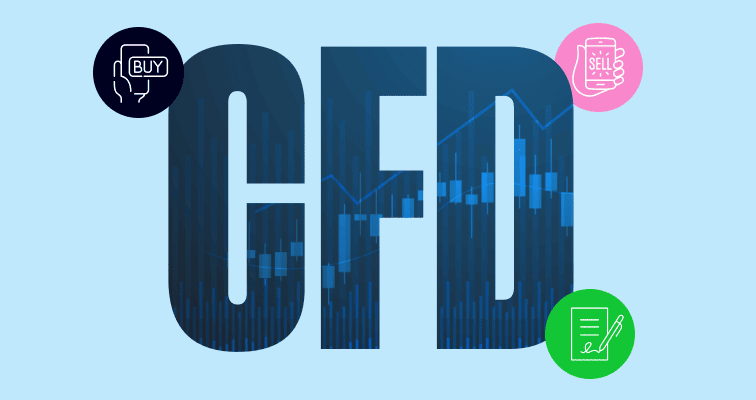This article will explain, using clear and simple language, the essentials of CFD trading, how CFDs work and what advantages they offer. We will look at examples to illustrate the different aspects involved in a CFD trade, so that by the end of the article you should have a good working grasp of CFD trading and understand the ways in which CFDs can complement a trader’s investment portfolio.
Definition of a CFD
A CFD is a type of trading instrument that offers a convenient way of gaining exposure to various financial markets. The term itself (CFD) is an initialism of Contract for Difference.
In a nutshell, a Contract for Difference is an agreement between two parties to settle the change in value of a given market or asset between the opening of a trade and its closing.
When you trade a CFD, you are one party to the transaction and your direct counterparty is the CFD provider.

How CFDs work
Because a CFD is an agreement to settle a change in the value of an asset, no asset is actually changing hands. A trader can buy an asset’s price if they expect it to rise, or sell if they expect it to fall. The trader chooses when to close the trade and at that point, their profit or loss is crystallised according to how the price has moved in relation to their opening level.
TIP: Effectively, a CFD replicates the profit or loss a trader would have made if they had traded the actual asset.
The easiest way to illustrate how this works is by looking at some examples.
Example 1: Going long with a stock CFD
Let’s say you think that the value of Coca-Cola has a good chance of rising in the near future. One way you could try and profit from this view would be to buy some actual shares in the company, but instead, you decide to buy Coca-Cola as a CFD.
You check the price with your CFD provider and the bid/offer in the market is 64.29/64.50. You decide to buy 100 shares with an “At Market” order. This means you buy at the current offer price in the market. You, therefore, buy your 100 shares at $64.50.
If you were buying actual shares in Coca-Cola, the purchase of 100 shares at a price of $64.50 would cost $6,450. That would be your investment in the stock.
When traded as a CFD, however, the deal is leveraged, meaning you only have to deposit part of the underlying asset value.
When trading CFDs on eToro, you have a choice of leverage, allowing you to opt for whatever best suits your attitude to risk. In this case, you could choose 2x leverage or 5x leverage (larger leverage is also available to professional level clients). Let’s say that you choose 5x leverage.
This means that the underlying asset value is five times larger than the deposit required for your CFD trade. In other words, you will only have to put down 20% of the asset value.
TIP: 5x leverage means the asset value is five times larger than the deposit required
Remember, we said the underlying asset value was $6,450.
$6,450 x 20% = $1,290.
You would need $1,290 deposited in your trading account in order to trade $6,450 worth of stock.
Scenario 1: Coca-Cola’s share price rises
Let’s say that over the next few weeks Coca-Cola’s share price rises as you expected. When you see the price trading at 67.40/67.52, you decide to take your profit by selling to close. You sell 100 shares at the market bid of $67.40 in order to completely close your position.
You opened your trade by buying at $64.50 and you closed by selling at $67.40. This means you made a profit of $2.90 for each share you traded. As you were long 100 shares, this equates to a base trading profit of 100 shares x $2.90/share = $290.
To calculate your actual profit, we also need to consider trading costs. We said that when you trade on margin, you only put up a portion of the asset value.
Hand in hand with this, there is a funding cost — akin to an interest charge — that is levied when you hold a position from one day to the next. Let’s say that you held the position for 15 days with an average overnight cost of $1.80, giving you an overall funding cost of $27 for holding the position.
Trading profit: $290
Funding cost: $27
Overall profit: $263
Scenario 2: Coca-Cola’s share price falls
Not every trade works out! Let’s say the Coca-Cola share price falls in the weeks subsequent to your trade. When the price is at 62.20/62.40, you decide to cut your losses. You sell 100 shares at the bid of $62.20 to close your position.
You opened your CFD trade by buying at $64.50 and closed by selling at $62.20. This is a loss of $2.30 per share. Since you bought 100 shares, this means a base trading loss of 100 shares x $2.30/share = $230.
Your overall loss will also include your cost for holding the position. Let’s say you held the position for 10 days for a combined cost of $18.
Trading loss: $230
Funding cost: $18
Overall loss: $248
Example 2: Going short with a stock CFD
Let’s say you have been watching Tesla’s share price fall and expect this price trend to continue. You decide to go short with a CFD trade, looking to profit from any further declines in its share price.
The bid/offer in the market is 162.50/163.02. You decide to sell 20 shares at the market bid of $162.50.
When going short with a CFD on eToro, you can choose to use no leverage and put up the entire underlying asset value based on your opening level. Alternatively, leverages of 2x and 5x are available (once again, higher leverage is available for professional investors). You opt for 5x leverage.
The underlying asset value is $162.50/share x 20 shares = $3,250.
You only need 20% of this value as margin. Your margin requirement for the trade is, therefore, $3,250 x 20% = $650.
Scenario 1: Tesla’s share price falls
Your view proves correct, and a few days later, you decide to take your profit when the market is trading at 154.78/155.30. You buy back 20 shares at the offer price of $155.30 in order to fully close your CFD trade.
Opening price: $162.50
Closing price: $155.30
Difference: $7.20
Your base profit is, therefore: $7.20/share x 20 shares = $144
Your overall profit would also include your cost for holding the position. Let’s say you held the position for five days with an average overnight cost of $0.60, for a combined total of $3.00.
Trading profit: $144
Funding cost: $3
Overall profit: $141
Scenario 2: Tesla’s share price rises
The price of Tesla rebounds, leaving your trade in the red. You decide to cut your losses and buy back 20 shares of Tesla when the market price is 169.58/170.10 to close your position.
Opening price: $162.50
Closing price: $170.10
Difference: -$7.60
You made a trading loss of $7.60/share x 20 shares = $152
Your overall loss would also include your overnight fees. Let’s say you held the position for ten days for an aggregate cost of $6.00.
Trading loss: $152
Funding cost: $6
Overall loss: $158

What can you trade with CFDs?
CFDs are frequently used to trade share prices, but they are not at all limited to just the stock market. In fact, you can trade a very wide selection of markets using CFDs all through one provider.
This includes:
- Currency exchange rates (in other words, Forex), such as EURUSD, GBPUSD and USDJPY
- Stock index levels, such as the UK100, the DJ30 and the NSDQ100
- Commodity prices, such as oil, gold and natural gas
- ETFs, such as the SPDR and QQQ
- Cryptocurrencies

Advantages of CFD Trading
CFDs offer a number of benefits that can make them attractive over conventional forms of trading. These include:
Free of stamp duty
Depending on the country in which a company is listed, you may have to pay stamp duty when purchasing shares. For example, if you buy shares in a company incorporated in the UK, you pay 0.5% in duty. When trading CFDs, you do not pay this cost. CFDs are free of stamp duty or Stamp Duty Reserve Tax (SDRT)*
Go short as well as long
When trading CFDs, it is just as easy to go short as it is to buy. You do not have to already own shares in a company in order to sell it, which offers the opportunity of capitalising on falling stock prices as well as rising markets.
One-stop shop
You can trade a wide selection of markets as CFDs all in one trading account with eToro. From hundreds of share prices, to Forex rates or even the price of oil, you can easily back your view with the convenience of just one account.
Leverage
As we saw from the examples above, one of the benefits of CFDs is that you often do not have to put up the full value of the underlying investment. This means you are able to command a more valuable position than the sum you deposit as margin. A range of leverage options are available on eToro, offering you the flexibility to tailor your risk in line with your preference.
Hedging
Because they give you the ability to go short, CFDs are a flexible method of hedging an existing position. For example, if you owned shares in a certain company and had concerns about its short-term performance, but did not want to liquidate your position, you could go short with a CFD as a temporary means of reducing your exposure to changes in its share price.
Summary
CFDs are a useful tool that both retail and professional traders utilise to gain convenient exposure to a variety of markets including shares, stock indices, currencies and commodities. Advantages such as leverage and the ability to go short mean CFDs offer a dynamic alternative to conventional forms of investing.
This article is the first in a five-part course aimed at providing trading education that goes beyond basic skills. The next part in the series is called: “Using Orders to Aid Your Trading.”
If you want to try out CFDs on real market prices, but without risking any money, why not try eToro’s demo account? It allows you to practise CFD trading using virtual funds.
Quiz
FAQs
- Are CFDs only for trading shares?
-
No. You can trade a wide variety of products using CFDs, including FX, commodities and indices.
- What happens with a dividend if I buy a share CFD?
-
If a share pays a dividend, the value will be credited to your account if you hold a long CFD position in the share past the end of day on the ex-dividend date.
- What happens with a dividend if I hold a short CFD position?
-
If a share pays a dividend, the value will be debited from your account if you hold a short CFD position in the share past the end of day on the ex-dividend date.
This information is for educational purposes only and should not be taken as investment advice, personal recommendation, or an offer of, or solicitation to, buy or sell any financial instruments.
This material has been prepared without regard to any particular investment objectives or financial situation and has not been prepared in accordance with the legal and regulatory requirements to promote independent research. Not all of the financial instruments and services referred to are offered by eToro and any references to past performance of a financial instrument, index, or a packaged investment product are not, and should not be taken as, a reliable indicator of future results.
eToro makes no representation and assumes no liability as to the accuracy or completeness of the content of this guide. Make sure you understand the risks involved in trading before committing any capital. Never risk more than you are prepared to lose.
*Tax laws are subject to change and depend on your jurisdiction and individual circumstances. Please check with a tax advisor if in doubt.


